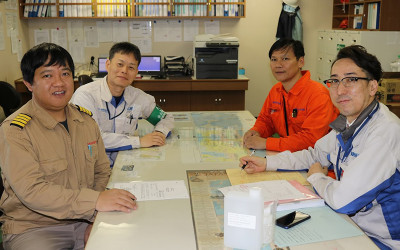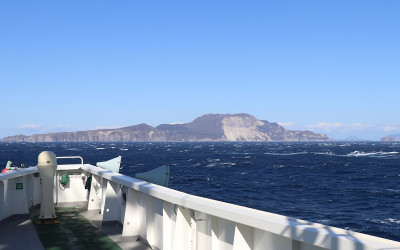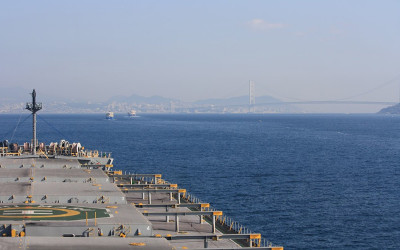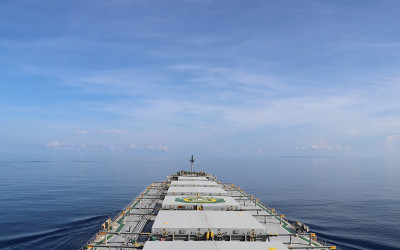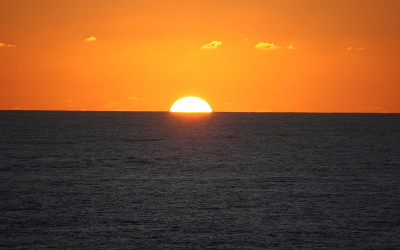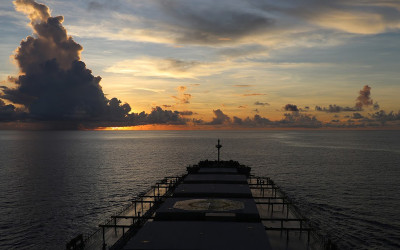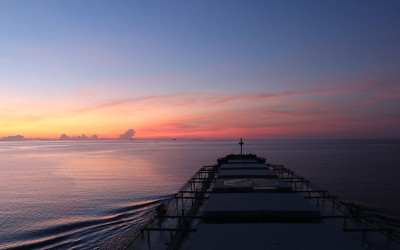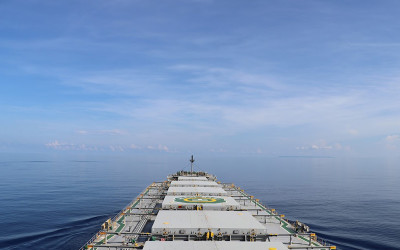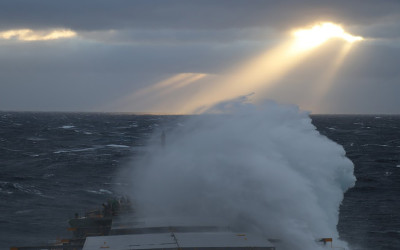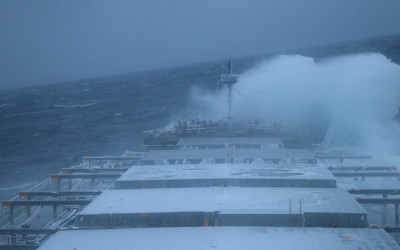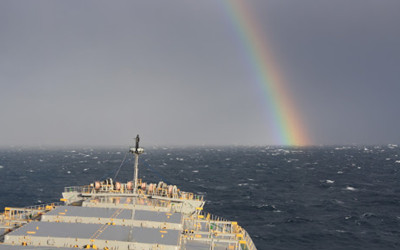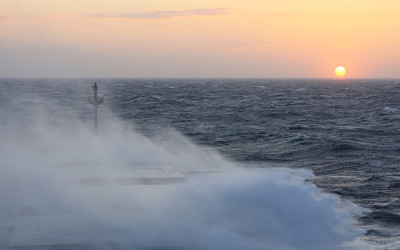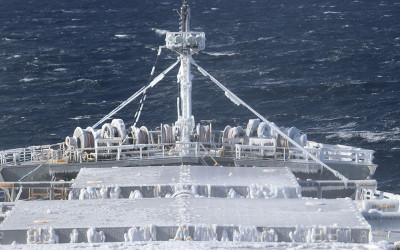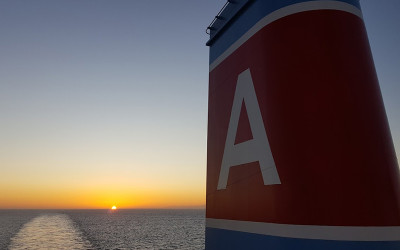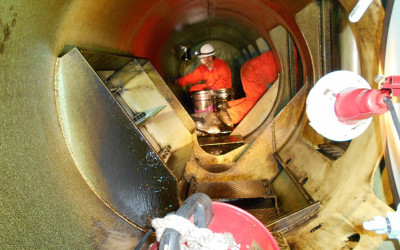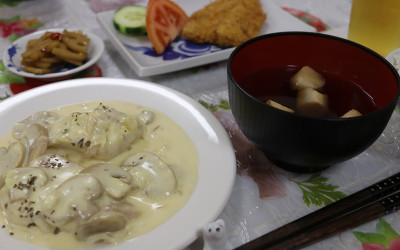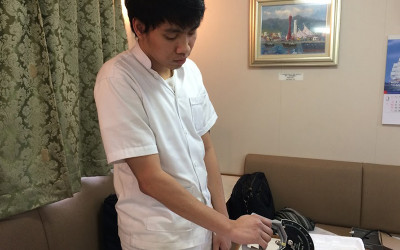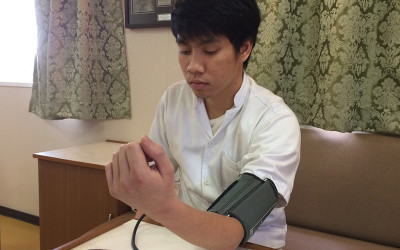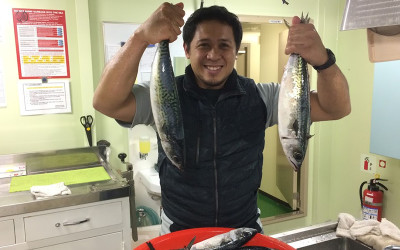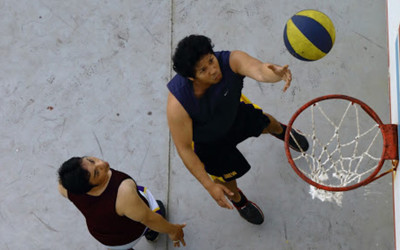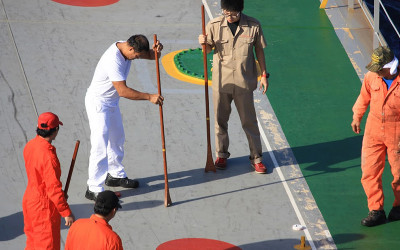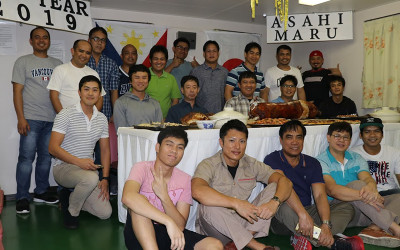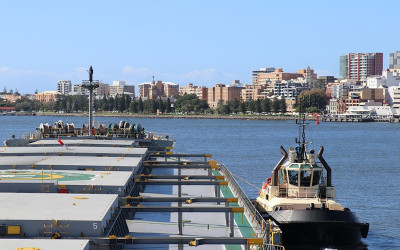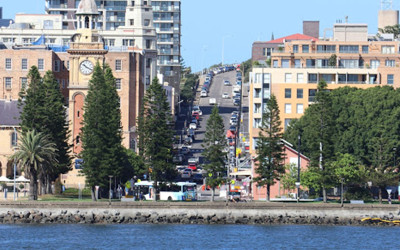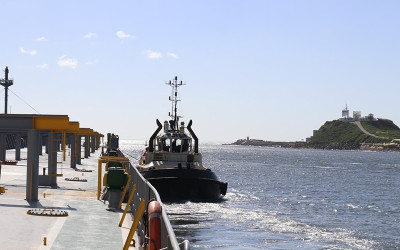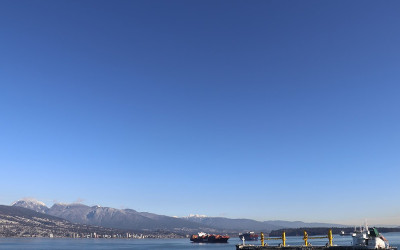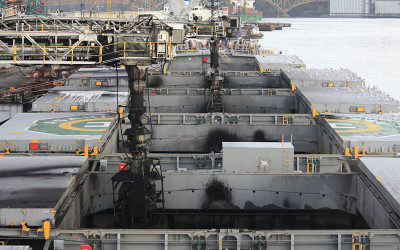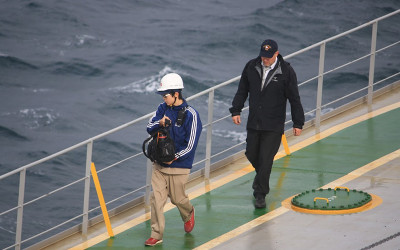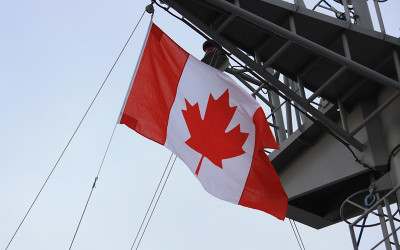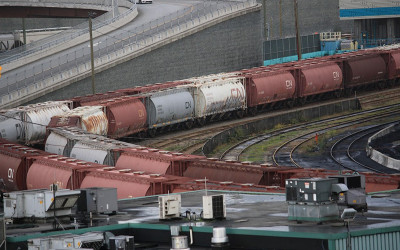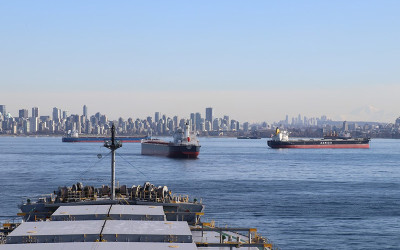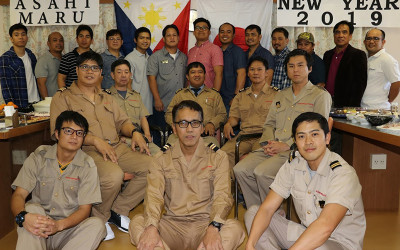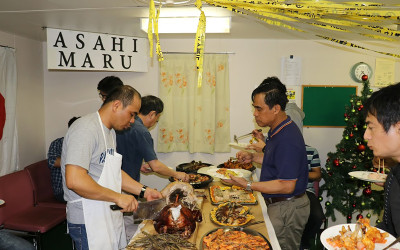Mother Port Kakogawa
Unloading
The Asahi Maru’s port of registry is Kakogawa (Port of Higashi-Harima). When calling at Kakogawa, which can be called the ship’s mother port, I coordinate the cargo operation plan and refueling and submit the port call documents with people I know, such as the foreman and agent.
Sometimes, we casually chat about the voyage to Kakogawa or where the ship might sail next.
The photograph on the left was taken about ten years ago in the office of the previous Asahi Maru (in service from 1994 to 2017), and the same foreman can be seen in the picture.
Although the times may change with ups and downs along the way, this relationship has continued unchanged.
Japanese Pilot & Akashi Kaikyo
Pilot & Akashi
The start of each voyage is the moment the final mooring line (ropes that secure the ship to the pier) is detached from land.
Once the final mooring line is free, we leave the port, and the first challenge is the Asahi Kaikyo.
We navigate based on the instructions given by the pilot.
Occasionally, we have to battle strong tidal currents of three knots or more.
While staying in the center of the designated lane and paying attention to the other ship traffic, we sail through the Asahi Kaikyo.
Once we are safely through, the Osaka bay pilot comes aboard and guides us to Tomogashima.
After the bay pilot safely disembarks and we navigate through the Kii Channel, it marks the start of sea passage (SOP) when we increase the engine revolutions and maintain a steady speed.
We set course to the next port of call and start the ocean voyage.
Glassy Sea
Voyage Australia
When sailing to Australia, one of the Asahi Maru’s main ports of loading, the weather and sea are generally calm.
In particular, around Papua New Guinea, the ocean is so flat that it almost looks like a mirror and it feels as if we are sailing on a lake.
Also, in the hot, humid air typical of the tropics, it is sometimes possible to see the instant a tornado reaches down from the cumulonimbus clouds that climb high into the sky.
This area is also the fishing grounds of large Japanese skipjack boats, so it is necessary to keep a watchful eye open.
After passing through the Jomard Channel, which is the doorway to Australia, we arrive in Northwest Australia. From there we enter the Coral Sea, home of the Great Barrier Reef.
Rough Sea
Voyage Canada
Compared to the voyage to Australia, the voyage to Canada is punishing. Particularly in the winter season, well developed low pressure systems with typhoon like winds successively move in from Eurasia.
We sail east towards the Bering Sea, which is known as the graveyard of low pressure systems.
The rough seas cover an area of the ocean as huge as the Japanese islands, so there is no avoiding it.
What happens to the ship during such rough weather? It rolls (sways side to side) at a 35 to 40 degree angle, and the pitching (vertical swaying) and punching (waves hitting the hull) cause the ship to significantly bend.
It is sometimes impossible to sleep in bed at night.
In order to reduce the burden on the hull and engine, we lower the speed until the rough weather passes and wait it out.
Frozen ship
Navigation in cold climate
When sailing across the Northern Pacific, we take the shortest route known as the great-circle route.
After passing off Nojimazaki in Chiba Prefecture, we head north and sail to the east of Kamchatka Peninsula in Russia.
Near Attu Island, we change course and enter the Bering Sea.
Around this point, the air temperature drops below zero, and the ocean temperature also falls.
The ship, which is made of steel, immediately gets colder and slowly starts to freeze.
The white, frozen hull of the ship has a unique beauty, almost as if it is an ice carving. As we travel further east, the ocean temperature rises and the ice thaws.
Deck Department
Introduction of the duty of deck
The occupation of a navigation officer who travels the world is appealing for its grand scale.
The primary mission is to safely transport the customer’s cargo from one port to another.
At the same time, we are transporting cargo valued in millions of dollars, so it is possible to work with an awareness and pride of being part of supporting the Japanese economy.
Furthermore, the navigation officer is responsible for the lives of 20 or more seafarers during the voyage, as well as for steering the company’s ship worth several tens of millions of dollars.
Although it is a huge responsibility, the job is also very rewarding.
On the other hand, being able to see sights only visible from the sea is also one of the privileges of being a navigator.
When out in the open ocean, the ship is completely surrounded by water in every direction as far as the eye can see.
Both the sky and the sea put on a different face every day.
The starry sky viewed from the ship is more beautiful than anyplace on land, and the steadily moving constellations makes it possible to feel the earth’s movement.
Navigation officer is the only occupation that provides such romanticism.
Engine Department
Introduction of the duty of engineer
“◎Investigating every corner of the ship during the daily UMS check Aboard UMS ships, nobody is in the engine room at night. Regular patrols are conducted. If an abnormality occurs, the UMS (unmanned system) sounds an alarm in the room of the engineer on duty. When the alarm sounds at night, it is sometimes impossible to get enough sleep, making work the next day very difficult. During the UMS check conducted every day, every corner of the ship is confirmed, from the engine room to the bridge. All of the pressures and temperatures are recorded, so it is possible to analyze the status of the equipment by comparing the readings with the past records. If the abnormality is not resolved, the engine room cannot be switched over to UMS, and the regular shift system is implemented. ◎Maintenance work is teamwork! The ship’s main engine is very big, and there is almost no work that can be done by one person alone. Also, the main engine, generators and air compressors make a lot of noise, so it is impossible to have a conversation. For this reason, the toolbox meeting held in the control room is very important. Even when the ship rolls heavily in bad weather and it is impossible to sleep at night, everyone must show up for work on time. During the maintenance work, while concentrating on our own work, we also pay attention to the work being done around us and help each other. The work is performed quickly and correctly so that no mistakes occur, and when we are able to finish the work as planned, the feeling of togetherness increases within the Engine Department. ◎Whenever a strange sound occurs, it draws my attention, making it impossible to fall asleep at night Engineers have no interest in the beautiful sights in the ocean and care only about the engine, such as what maintenance will be performed during the next major overhaul or what spare parts will be replaced. Or how to respond in the event of assumed emergencies. Unless we think about these in advance, it is impossible to act when trouble occurs in the middle of the night. Also, hearing strange sounds makes me start to worry and be concerned. When I understand the cause of a problem, it makes me feel that I have grown a little bit more as an engineer. The more I know about the engines, the more questions that start to arise, and persistently pursuing the answers is something I enjoy doing.On-board cuisine
Introduction onboard meals
The unsung heroes who support safe operations are the members of the catering department.
The Chief Cook, Second Cook and three Messmen (Filipinos) cook the food for about 18 people in the deck and engine departments.
They provide daily meals that include subtle touches to satisfy the crew members with even the most discerning palates.
It is also their job to manage the food items, and they strictly manage the inventory to ensure the ship does not run out of food before reaching the next port.
The pantries are always fully stocked with fresh food when the ship leaves each port.
Meal times are always some of the best times of the day.
I wonder what will be for dinner tonight.
Maintaing good health
Health Supervisor
At the end of every month, a health check-up including weight, blood pressure, grip strength, urinalysis and lastly, an alcohol test is done. Because the ship is operated by a limited number of people, all of the crew members pay attention to managing their own health.
Despite these efforts, occasionally minor illnesses occur, such as catching a cold. For such events, the ship’s hospital room is always stocked with medication as set forth in Article 81 of the Mariners Act. The person (crew member) qualified as a ship health supervisor provides the necessary response. Sometimes, wireless healthcare is used in which the procedures are performed while receiving advice from a physician through the telephone, fax or e-mail.
In addition, should an emergency occur, the crew member is urgently disembarked at the nearest port or by means of a coast guard (in Japan, the Maritime Self-Defense Force) helicopter.
Recreation on board
Introduction of the Recreation
Work aboard the ship is conducted based on a three shift system with each shift running from 8am to 12pm, 12pm to 4pm and 4pm to 8pm, respectively.
Also, the engine department works during the daytime. The other times, excluding during standby (preparing) when the ship is entering and leaving port, are free time, and each crew member enjoys this free time in his or her own way. Some play basketball, while others fish while the ship is at anchor (engine is stopped and the anchor is lowered) or workout in the gym. In terms of culture, we watch movies, sing karaoke and play games. A monthly entertainment budget is included in the ship’s expenses, and the crew member in charge of entertainment finds innovative ways to make the most of the budget.
Cooperation each other
Introduction of Seafare(JPN&PIL)
The ships owned, operated and managed by the company are manned by Filipino seafarers.
Also, the Asahi Maru, which is owned by the company, is known as a multinational ship that is manned by both Japanese and Filipino seafarers.
Both nationalities deepen their bonds while understanding and respecting each other’s culture, religion and daily traditions, and they use this to improve communication and conduct safe operations.
Many Filipino people are Christians, so including the Christmas party for all crew members and birthday celebrations, the events aboard the ship never end. Actually, in the Philippines, the person celebrating a birthday prepares the food and drinks and invites others to the celebration.
It is the opposite of the tradition in Japan.
Helicopter Landed on CH.4
Australian Pilot
On the 14th or 15th day of the voyage from Japan, we arrive at the Port of Newcastle in Australia.
Upon reaching the entrance to the port, a pilot arrives on a helicopter.
The heading and speed of the ship are adjusted, and preparations are made so that the helicopter can land easily.
The firefighting and medical teams standby near the helicopter landing hatch (cover of the No. 4 cargo hold) just in case the helicopter crashes. After the helicopter lands safely, the navigation officer in charge takes the pilot to the bridge (control room).
Then, after sharing information such as the tug boats, turning points and points to note with the bridge team (captain, navigation officer and helmsman), the pilot provides guidance until the ship arrives alongside the pier.
Newcastle Australia
Loading Operation(AUS)
The Port of Newcastle is the main port in Australia for exports of metallurgical and thermal coal.
At the entrance to the port is a white lighthouse known as Nobby’s Head Lighthouse, and the Vessel Traffic Information Center (VTIC) for the port is located on the lighthouse premises.
Also, the ship’s arrival time is decided based on this lighthouse, and because the official arrival time is the time when the ship arrives within a 10 mile arc drawn from the lighthouse, it plays an extremely important role.
A unique characteristic of Newcastle is the church on a hill and the lack of high-rise buildings in the downtown area such as those commonly seen in Japan.
The town is spread out and mostly single story buildings, and it is emblematic of a country with lots of wide open space.
On the other hand, there is not much free time in the cargo operations as the port is famous for its quick cargo operations, such as being able to fully load about 83,000 tons of coal in 17 or 18 hours.
Vancouver B.C. Canada
Loading Operation(CA)
After completing the harsh winter voyage across the Northern Pacific, the beautiful city of Vancouver backed by snow covered mountains comes into view.
While waiting at anchorage, it is possible to see seals swimming and the sights as a port town, such as yachts coming and going.
Cargo operations take a relatively long time here, so the crew members take turns going ashore.
This is the time for traveling into town, shopping at the local supermarket and refreshing the spirit for the voyage home.
Upon leaving port, a Canadian pilot guides the ship for 85 miles to the drop off point at Victoria Pilot Station.
It takes 7-8 hours to travel this distance, and we never forget to show good hospitality, such as providing coffee and other drinks, as well as offering Japanese food or other meals. Some pilots even ask for green tea.
Special Occasion
Christmas & Newyear Party, Biggest party ever
Christmas aboard the ship is a special time.
In the Philippines in particular, many people are Christians (Islam is the majority in Mindanao, the southern island in the Philippines), and the months that end in “ber”, namely September through December 24, are part of an important religious tradition and are said to be the time for making Christmas preparations.
It is the same aboard the ship, and everyone proposes ideas, such as decorations, meals and events.
Although it depends on the ship, if we are in the middle of the voyage, everyone takes time off of work for a party starting on the evening of the 23rd, and we celebrate the moment for 24th arrives.
I feel that the crew members who celebrate Christmas together on the ship develop particularly deep bonds.
At the start of the new year, everyone puts on fresh clothes for a commemorative photo.


